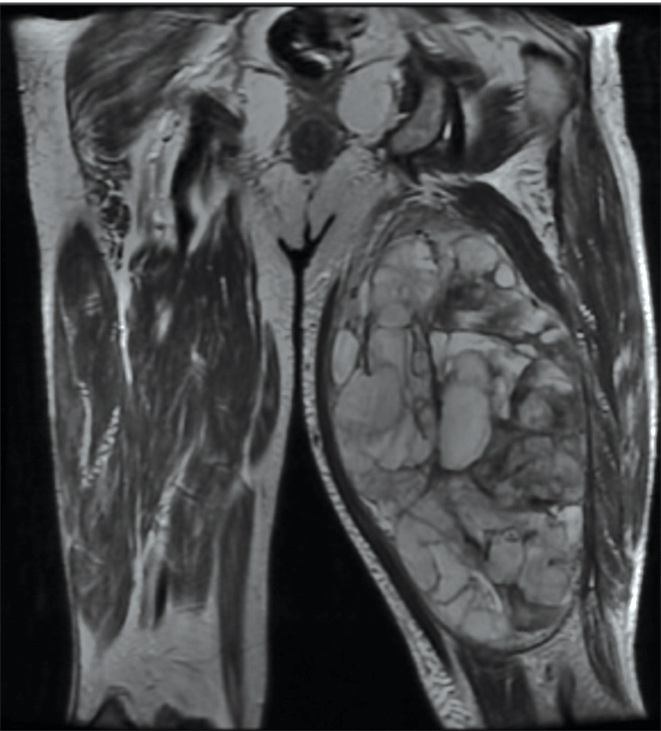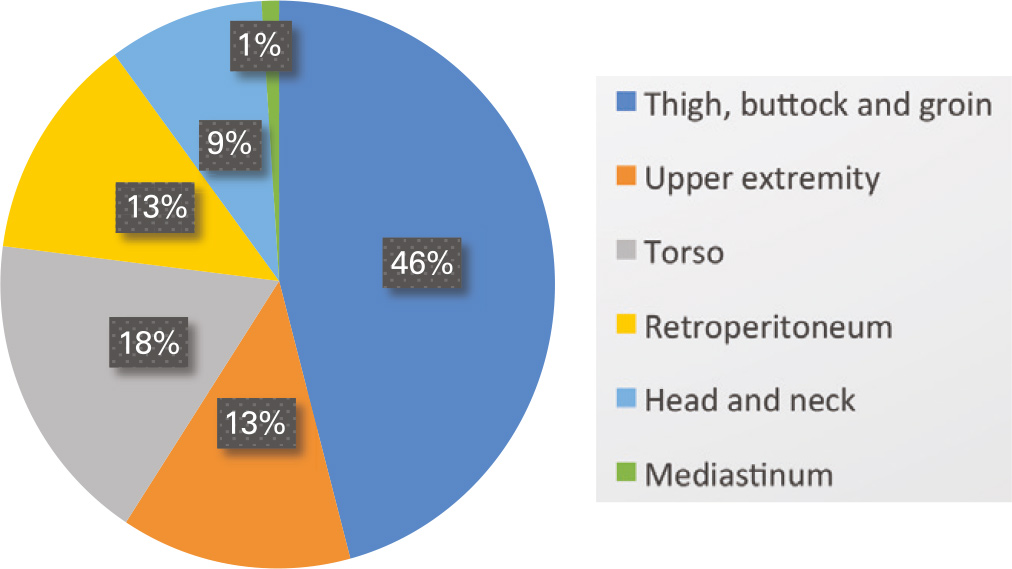Case
A man, 75 years of age, presented with an enlarging lump in his left thigh after he fell from the roof six months ago. He saw a general practitioner (GP) several weeks after the initial injury. An ultrasound scan showed a large intramuscular collection of 20 cm x 8 cm x 14 cm. The diagnosis of a large intramuscular haematoma was made. The GP advised him to manage the swelling with a warm compress and simple analgesics.
Five months later, the patient presented again because the lump had been growing and was affecting his ability to walk. The lump caused minimal pain; however, he reported weight loss of 10 kg and feeling fatigued. A physical examination revealed a large, firm, immobile mass with significant oedema in the medial aspect of the left thigh.
Urgent magnetic resonance imaging (MRI) was performed. The MRI showed a large lobulated heterogeneous solid mass measuring approximately 15.4 cm x 9.7 cm x 25.6 cm (Figure 1) situated between the adductor magnus, the semitendinosus and semimembranosus.

Figure 1. Magnetic resonance imaging of patient’s limbs
Question 1
What are the differential diagnoses?
Answer 1
The size, growth rate of the soft tissue mass and the patient’s systemic symptoms raise suspicion of a malignant tumour. The differential diagnoses include sarcoma, metastatic tumour or lymphoma.
Case continued
The patient lived three hours away from the tertiary referral centre, so his case was discussed over the phone with a sarcoma surgeon. An urgent consultation was arranged and, subsequently, a biopsy was performed. The biopsy confirmed the diagnosis of a myxofibrosarcoma.
Question 2
What is a myxofibrosarcoma?
Question 3
What are the clinical features of a soft tissue sarcoma?
Question 4
How can the diagnostic accuracy for sarcomas be improved?
Answer 2
Myxofibrosarcoma is a subtype of soft tissue sarcoma,1 a rare malignant tumour of connective tissues. Sarcomas account for <1% of adult malignancy and there are more than 100 histological subtypes.1 Myxofibrosarcoma is an aggressive subtype that usually occurs in elderly patients, predominantly in the extremities.1 It tends to recur locally and metastasise to the lungs and bones.2
Answer 3
Soft tissue sarcoma usually presents as a gradually enlarging, painless mass.3 In some cases, such as this one, patients present shortly after an injury. To date there is no evidence for a causal relationship between trauma and sarcoma. It is likely that the injury brings the patient’s attention to the tumour site, rather than causing the tumour.4 When the tumour grows to a certain size, it can compress the surrounding neurovascular structures, causing oedema and discomfort. There can also be associated systemic features, such as weight loss and fever.3
Sarcomas tend to favour the extremities. Figure 2 shows the anatomical distribution of soft tissue sarcomas in 4550 adults collected by the American College of Surgeons.5 Clinical features that have been identified as suggestive of a sarcoma are listed in Box 1.3,6,7

Figure 2. Anatomical distribution of soft tissue sarcomas in 4550 adults5
Box 1. Clinical features suggestive of sarcoma3,6,7
|
Size >5 cm in any diameter
Deep or inherent to fascia
Painful or tender
Rapidly increasing in size
Recurrence of a lump after previous excision
|
Answer 4
Diagnosis of soft tissue sarcoma is commonly delayed. Given that sarcomas are rare, and it is much more likely for GPs to encounter a benign lump than a sarcoma,deciding which lump to investigate further can be difficult.3
Patients with an initial diagnosis of an intramuscular haematoma should be re-assessed in four weeks to ensure improvement or resolution. If the lesion does not improve or resolve, the diagnosis of a sarcoma should be suspected.
The current recommendation for a suspected sarcoma is an urgent referral to a sarcoma unit.8 However, many remote communities in Australia do not have immediate access to a specialist centre. In such situations, the diagnosis of a sarcoma will rely heavily on the GP’s clinical skills and awareness of sarcoma. When a sarcoma diagnosis is suspected, a phone consultation with a sarcoma specialist may help to provide guidance on further investigation and management.
Case continued
Further imaging at the specialist unit found metastases in the patient’s lungs. The patient underwent radiotherapy and subsequently had surgical excision of the soft tissue sarcoma on his left thigh. The surgical excision was of palliative intent because of the metastatic lung disease. At the time of writing, he had returned home and had recovered well from his surgery.
Key points
- Consider malignancy in the differential diagnosis of a soft tissue mass.
- Be familiar with the clinical features of sarcoma.
Author
On Bon Chan MBBS, FRACGP, BAppSc (Physiotherapy), DCH, Certificate of Dermoscopy, General Practitioner, Sale Medical Centre, Sale, Vic. louischan451@gmail.com
Competing interests: None.
Provenance and peer review: Not commissioned, externally peer reviewed.
Acknowledgements
I would like to thank Dr Wing Ka Vicki Chan and Dr Iain Nicholson for reviewing this article.